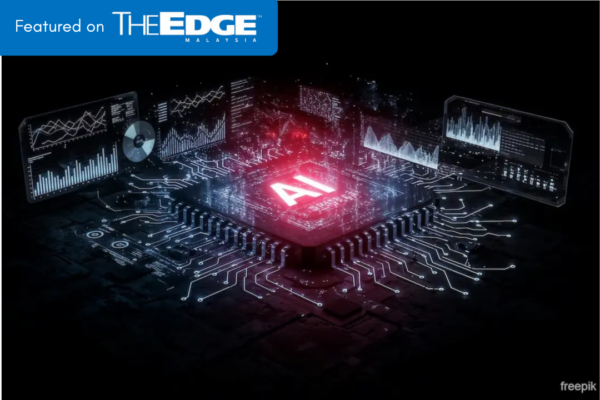Your Data can Helps You to Predict the Future Accurately
Predicting the future? Some of us might wish to gain this power but some might judge about that. Many technology companies claim that they are able to predict the future with technologies like Artificial Intelligence and Machine Learning. However, is it really possible to predict the future or is it only some advertising tricks to grab consumer’s attention? The answer is, YES! Technologies could certainly help us to predict the future, but the right question to ask is “Is the predictions accurate enough and worth for a huge investment?”
Based on IDC global survey of 2,473 organisations from May 2019, 25% of organizations worldwide that are already using AI solutions report up to 50% failure rate mainly due to lack of skilled staff and unrealistic expectations. Thus, how can we improve the successful rate of AI projects and what are the other advanced technologies that should be involved to enhance the accuracy of predictions?
How to Predict the Future Accurately by Leveraging Big Data with Advanced Technologies
1. Enrich the data with Artificial Intelligence tools
Based on the projections from IDC, 80% of the worldwide data will be unstructured by 2025. The examples of unstructured data are audio, video, photos, text files/ PDFs, Communications and IoT sensor data. Since unstructured data does not have a pre-defined format, it cannot be easily search through, read, store or analyse unlike structured data.
Some of the technologies companies have already successfully designed AI-driven data acquisition and data integration system to acquire, store and mash-up all relevant internal and external data from multiple sources including both structured and unstructured data that provide a more holistic view of your data in nearly real time to enhance the analytics results.
2. Use Natural Language Processing to Gain Deeper Insights
Natural Language Processing or NLP is a field of Artificial Intelligence that gives the machines the ability to read, understand and derive meaning from human languages. (Source from Towards Data Science) NLP techniques or tools assist businesses functions from chatbots and digital assistants, compliance monitoring, BI, to analytics.
It helps businesses to process, analyse, and understand all of the unstructured and semi-structured contents that can bring significant insights such as queries, email communications, social media, videos, customer reviews and support requests. NLP technique is being utilised by businesses in several areas which includes sentiment analysis, customer service, advertisement and market intelligence.

3. Develop the Predictive ML Models with Cognitive Engine
Cognitive technologies for predictions utilise a range of machine learning, big data, and statistical approaches to process large volumes of information, identify pattern or anomalies, and recommend next steps and outcomes. (Source from Forbes)
It incorporates all relevant data into models to develop the effective predictive machine learning models by applying several Machine Learning algorithms such as knowledge graph, reinforcement learning, supervised learning and unsupervised learning. In short, it allows us to build, validate and enhance the predictive models to “leave no stone unturned” and generates actionable predictive outcomes.
4. “Connect the dots” with Knowledge Graph
Knowledge graphs have been announced to be on the rise together with augmented intelligence and explainable AI based on Gartner’s 2019 Hype Cycle for Emerging Technologies.

Source from: Gartner, August 2019 (Gartner Hype Cycle for Emerging Technologies, 2019)
A Knowledge Graph is a technology that connect and represent knowledge in an area of interest using a network of nodes and links. (Source from Deloitte) It allow us to gain actionable and deeper insights on impacts and links of the entities by analysing the multiple relationships and interactions while discovering the hidden patterns or suspicious behaviours.
One of the successful use cases for knowledge graph technology is Netflix. After deploying the knowledge graph, Netflix is able to predict what customers might like to watch next, and foster the “binge-watching” model of consumption by drawing connections between movies and TV shows and the actors, directors or producers. (Source from Forbes)
Type of Predictions and Its’ Benefits
- Fraud detection – Detect suspicious fraud behaviour and predict future patterns in order to reduce fraudulent loss by preventing fraud occurrence
- Credit Risk Scoring – Assessing customer’s creditworthiness to identify the customer’s ability to repay.
- Market & Competitive Intelligence – Generates consumer & product insights from regulators, industry players and competitors for optimise market penetration.
- Talent Insights – Improve employees’ capabilities, potential and loyalty with employee retention analysis and enhance talent management.
- Cyber security – Identify credible cyber threats and automate responses to block threats or mitigate their effects.
- Foresight – Enhance strategic decision making with accurate data-driven insights.
Predict the Future Accurately with the Right Tools
Predict the future is real due to the fast advancement in technologies but without innovation, you will only be “walking on a treadmill” or even stepping backwards. However, producing fast and numerous predictions doesn’t always bring significant values, making sure of high accuracy and fast predictions are the main focus here in order for you to make the right decision quicker that allows you to successfully turn potential challenges into opportunities while taking immediate action based on the uncovered trends and patterns. Therefore, choosing the right tools is also an extremely important task before making your digital transformation decision. Gain deeper insights by understanding your data now to predict the future accurately and achieve your desired outcomes with the right tools.













